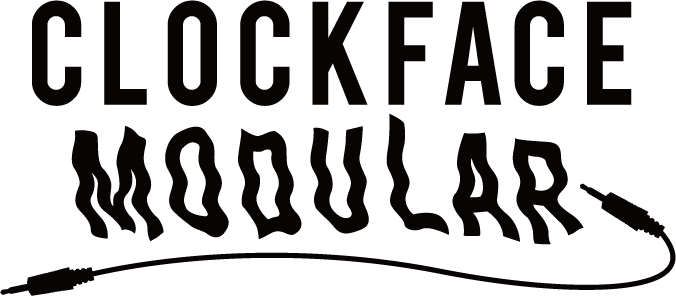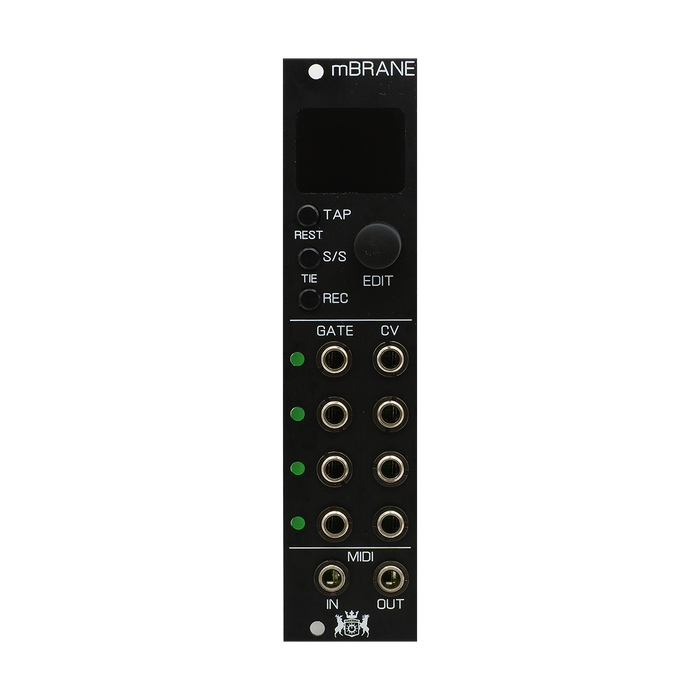MUSICAL FEATURES
mBrane is a creative MIDI converter module that is equipped with a highly functional MIDI → CV/Gate conversion that can be used in a variety of settings, a 101-step sequencer that inputs using a method similar to the SH-64, and even a digital oscillator.
YarnsThis is a compact and high quality clone module.
All settings are done by simple operations by rotating the encoder and clicking. Use it by turning the encoder to select the option you want to set, then turning it again to determine the value or setting for that option.
All settings can be stored in 8 presets. Save and load by pressing and holding the encoder to access the S (AVE) and L (OAD) menus (preset 1 is always loaded after powering on the module).
layouts
In mBrane, the biggest setting for how to convert MIDI to CV/Gate is "
LayoutThis setting is determined by mBrane's "LA(YOUT)" option (see the knob description for how to set the option).The layout determines how many voices go on which MIDI channel. A MIDI channel is called a "part".A voice is a single note (monophonic) melody.
After selecting the LA (YOUT) option, the setting values that can be selected are as follows.
- 1M: Converts one monophonic sound.
- 2M: Converts two monophonic sequences. The two are on different MIDI channels.
- 4M: Converts two monophonic sequences. The two are on different MIDI channels.
- 2P: A duophonic mode in which one part (MIDI channel) can simultaneously convert up to two sounds.
- 4P: Quadruphonic layout that converts up to 1 sounds simultaneously in one part (MIDI channel). You will be able to convert 4 chords.
- 2> 4> / 8>: These are layouts where two mBranes are chained together with MIDI cables to output many voices. 2>, 2>, 4> Each mBrane outputs half the number of voices (8, 1, 1,2,4).
- 4T: Quad trigger layout. Each of the four parts outputs a trigger signal in response to the on / off of only one scale.
See the "Options" section below for layout and output settings.
Clock and Tempo
The tempo can be set by selecting the optional TE (MPO).The tempo is in BPM units and only the last two digits are displayed.The numbers will flash at that tempo when set. If you turn the encoder to the left of 2 BPM, EX (TERNAL) will be displayed and you can synchronize with the external MIDI clock.The internal clock can swing. Please set from the SW (ING) option. In the 40M, 1M, 2P, 2>, 2>, 4T layout, the clock can be output, but it is also possible to output the divided clock with respect to the MIDI clock. Set with the O / (OUTPUT CLOCK DIV) option. please.It is also possible to set the tempo itself by dividing the clock. Set with the I / (INPUT CLOCK DIV) option. Even with a 4M / 4P / 4> layout, it is possible to replace the gate 8/3 output with a clock output. Set from the C> (CLOCK OUTPUT) option.
Arpeggio
In mBrane, when you enter a chord for each part, it is broken down into an arpeggio and played.Arpeggio settings are accessed from the options below.Among the setting items, the three parameters labeled "EUCLIDEAN~" are the three parameters given to the algorithm when "Euclidean algorithm" is selected for the arpeggio rhythm generation. pattern is determined).
- C / (CLOCK DIV): Arpeggio clock setting.
- G- (GATE LENGTH): Arpeggio gate length setting.
- AR (ARP RANGE): Sets the arpeggio range in octave units.When zero, arpeggio is disabled.
- AD (ARP DIRECTION): UP, DN (down), UD (up & down) RA (NDOM) mode, PL (AYED) is the arpeggio mode in the order in which they are pressed, and CH (ORD) is the gated chord effect mode.
- AP (ARP PATTERN): Sets the arpeggio rhythm pattern. If the lower E- is not 0, this setting is invalid and the Euclidean algorithm rhythm pattern is used.
- E- (EUCLIDEAN LENGTH): Sets the rhythm pattern loop length using the Euclidean algorithm. When 0, the Euclidean algorithm is disabled.
- EF (EUCLIDEAN FILL): Use the Euclidean algorithm to set the number of "ON" rhythm patterns.
- ER (EUCLIDEAN ROTATE): Set the start position of the rhythm pattern using the Euclidean algorithm.
Oscillator
By setting the OS (CILLATOR) option to a waveform other than OFF, mBrane's built-in oscillator will be output.The output destination is as follows.
- CV1 in 4M layout
- CV2 and CV2 in 3M or 4P layout
- CV4, CV4, CV1, CV2 in 3M or 4P layout
Sequencer
Each part also functions as a 64-step monophonic sequencer.The input method is to press a connected MIDI keyboard or a button on the mBrane for each step, using the method found on SH-1 etc.To start input, press the REC button. If the layout has multiple parts such as 101M or 2M, you can select the part to record here.To finish inputting, press the REC button again.
For input, enter one of the following for each step.
- Note: Input by pressing the MIDI keyboard. Velocity is also recorded. AlsoPress down while tilting the pitch bend to enter a slide.
- Tie: Press the START / STOP button to enter the tie where the previous sound continues to grow.
- Rest: Press the TAP button to input a rest (REST).
You can also return to the previous step by turning the encoder during input. Also, by pressing the encoder, you can select the value of the note etc. to be input, so you can program the sequencer without a keyboard.
When input is complete, you can start and stop the sequence with the START / STOP button. In addition, the sequence will synchronize to the external MIDI clock in the mode that synchronizes to the external clock. If you enter a MIDI note during playback, the sequence will be transposed. If you press the REC button during playback, the sequence will remain the same, but if you input a MIDI note, the step at the time of playback of the sequence will be replaced with that MIDI note.
Sequencer cannot be used at the same time as arpeggio. Please note that if you press START/STOP or mBrane receives a MIDI start message, the sequencer will start and the arpeggio will stop.
Options
Layout and MIDI related options
- LA (YOUT): Select a layout.
- PA (RT): When selecting a layout with multiple parts, you can set the active part to be set.
- CH (ANNEL): Receive MIDI channel setting.
- NO (TE): Set a note for each voice in a 4T layout that creates 4 triggers with different MIDI notes.
- >> (OUTPUT MIDI MODE): MIDI OUT becomes OFF/THRU/arpeggiator (or sequencer) output depending on the settings.Also, 2>, 4>, and 8> are used for mBrane chains.
- VO (ICING): Settings for handling multiple voices in one part, such as 2P, 4P, 2>, 4>, 8>.
- PO (LY) Swap voices like a normal polyphonic synth.
- CY (CLIC) Notes are circulated through the voices and assigned. .
- RA (NDOM) Notes will be randomly assigned to voices.
- VE (LOCITY) Notes will be assigned in ascending order of velocity.
- NP (NOTE PRIORITY): Priority of notes when some keys are pressed. This can only be set in a monophonic layout, where one voice is assigned to one part. LO (W) est and HI (GH) est give priority to low keys and high keys. LA (TEST) gives priority to the most recently pressed key.
CV, gate and trigger related options
- LG (LEGATO): Legato setting. Valid for 1M, 2M, 4M layouts. When set to ON, signals are output so that overlapping notes become legato, and trigger signals are not output at the start of connected MIDI notes.
- PO (RTAMENTO): Adjusts the portamento (time-based) speed.
- BR (BEND RANGE): Sets the pitch bend range in semitone steps.
- VR (VIBRATO RANGE): Set the Vibrato range (Modulation Wheel range).
- VS (VIBRATO SPEED): Set the speed of Vibrato.
- T- (TRIGGER DURATION): Adjusts the length of the trigger pulse.
- T * (TRIGGER SCALING): This setting is valid only for 4T and determines how much the strength of the trigger signal will respond to velocity.
- T / | (TRIGGER WAVESHAPE): Outputs the waveform of the trigger pulse in various forms. Usually SQ.
- CV (AUX CV OUT): In a layout that has an "Assignable CV" output, you can set what is assigned to that output. Choose from AT (AFTERTOUCH), BR (EATH) controller (MIDI CC # 2), PE (DAL) (MIDI CC # 4), and LF (O) where you can set strength and speed with Modulation Wheel and Vibrato Speed options. .






